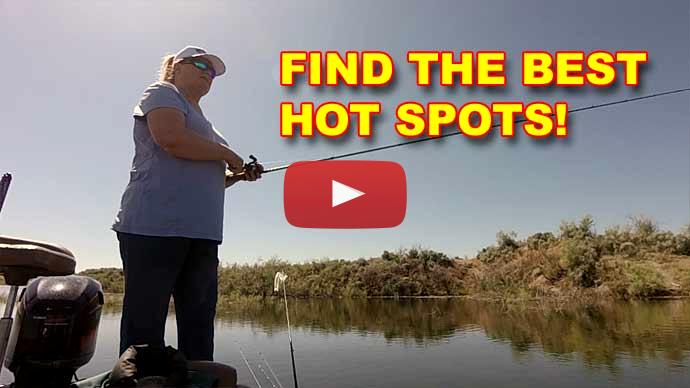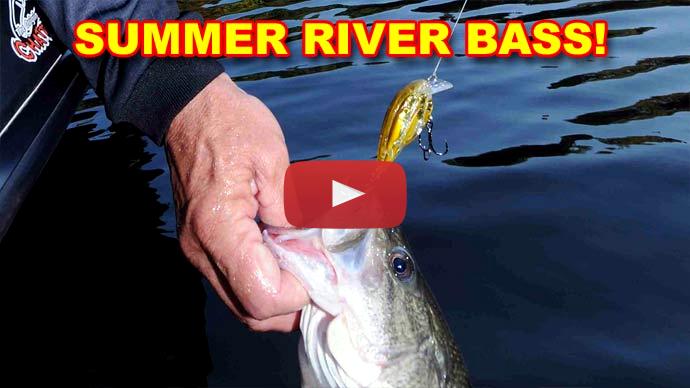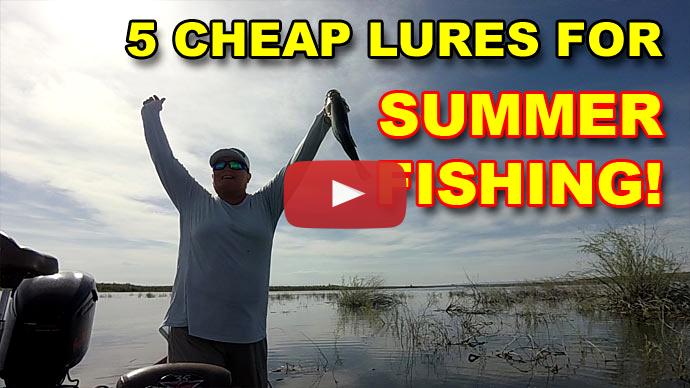Well, summertime is here. It's hot. It is hot out today. And bass fishing is on fire. I'm telling you what, bass, their metabolism is governed by the water and temperature. The higher the water temperature, the higher the metabolism, the more often they eat. So, there's more fish on the prowl looking to eat. So, what is the best lures you can use? Where do you fish? Let's talk about that because sometimes it can be difficult locating these fish and sometimes it can be difficult getting them to bite.
Let's kind of dive right into it. There's really three things you should think, three times a day to focus on for summer fishing. One is night fishing, the other is lowlight hours like early morning and evening, and the third is fishing during the day. And those require each different approaches and different baits.
So, let's start with night fishing, that's probably the easiest. Night fishing is great. Especially in the Southern U.S., it's almost a must because it's so hot and muggy, it's just darn right uncomfortable to be fishing during the day.
But at night, it cools down, the watercraft, they all get off the lake, and the bass come up shallow and they want to eat. So, it can be really fun. It's really easy to do lure selection there. You just want basically topwater bait, spinnerbait, jigs, and worms. And the color selection's very simple. Everything turns to shades of gray. Darker colors work best because they show up, they contrast the most against all the other shades. So, bait selection's super easy. Where to fish, I like to focus on docks that have lights on them or marinas that are all lit up, mainly because that attracts all the minnows. You have tons of minnow activity around that and insect activity. That attracts all the bait fish and, of course, the bass will be there too. So, you just pick a marina, launch there, and you can just fish inside the marina, never having to go anywhere, and you can catch a ton of fish that way.
The key thing about fishing at night is you don't have to wear sunscreen because you're at night, but you do have to wear insect repellent because the insects can be really bad. So, keep that in mind, and also keep your navigation lights on all the time. It is the law. You don't want to pay that nasty ticket. But night fishing is an excellent choice to have during the heat of the summer.
Now, if night fishing isn't your thing or maybe you're not able to do that, other alternatives is the early morning, late evening. With that, a lot of times the fish are still up shallow and they're actively feeding. This is a game of shadows. I want you guys to understand that. It's a game of shadows. Find the shadows. Typically, they're shadows that are cast early in the morning and late in the evening that is under bright sunlight otherwise during the day. Those shadow areas can be very productive during those lowlight periods. So be sure to hit those. You'd be surprised the areas you think that are just dead. If you got a shadow on it in the early mornin', it can be on fire until the sun hits it. I used to do this at a lake nearby my house, super busy lake, very popular in the middle of the city, ringed with houses. But you get out at the crack of dawn and you go down the... almost every dock had a fish on it. You bang, bang, bang, bang, bang, bang, bang until 8 o'clock, 9 o'clock, whenever the sun would come up and start hitting on those docks and the fish would be gone. Game over. And then you can just go put your boat on a launch and on your trailer and go home and do yard work, whatever else you need to do.
So, just topwater bites can be amazing in the morning. Don't forget spinnerbaits. Man, they can be really aggressive hitting spinnerbaits, crankbaits, these fast-moving lures, frogs. over matted vegetation, things like that can be really good during those lowlight hours. So that's definitely an option for you.
And then during the day, you've got two choices. You can go shallow or really deep. That's basically where the bass are going to be. Shallow, you need to have vegetation. It has to be present. It has to be thick vegetation because vegetation, it creates cover. It creates shadows. They actually generate oxygen. It creates hiding places for the baitfish to go. Insects and invertebrates are there, which is what the baitfish feed on. And there's a whole ecosystem within those vast expanses of vegetation, particularly if it mats over on the top and you got this matted vegetation. Those can be hotspots because underneath, even though the water temp on your boat will say it's close to 90 degrees. Underneath that canopy, it could be 5, 10 degrees cooler. And the cooler the water is, the more dissolved oxygen it can hold. So, there's a whole lot of activity going on underneath those canopies. So, fish those.
There's two ways to do it. One is on top using like a frog, a Hollow Body Frog, just skittering across the top. A spoon will do that too. Or you can punch it. Punching means you use a Texas rig bait, typically a slender bait. I like to use Senkos because they're really just a slender bait. But like a Rage Bug works really well. And a heavier weight, like a half ounce to an ounce and a half, depending on how thick that canopy is. But you throw it up in the air and let it land on the canopy and literally, it'll go nose first and punch through the canopy and the fish will be underneath there.
Couple things about that. Now, sometimes as soon as it punches through, whack, you'll get hit. So, you got to set the hook right away. You got to use stout equipment, man. You're talking heavy, a 7'6", 7'8", heavy power rod with 50-pound braid. You got to get them out of that cover. But be prepared for that bait to get hit as soon as it punches through the cover. Now, if it doesn't, you can get it on the bottom, you can fish it just like you normally would any plastic worm, just kind of jig it up off the bottom a little bit.
And what I like to do is I like to give violent pops because, again, fish are very active at this time, you don't need to slowly entice them. Let it sit on the bottom, give it a good... the pauses are longer. Because I feel the bass are cruising around looking for prey and so you wait and you wait and then you give it a pop and they react right away, immediately. It's just a reaction bite, boom, and they nail it. So, you pop it and you let it flutter back down. If you don't get bit and you wait, give it a good 15, 30 seconds, pop it again, and be ready for that strike.
Now, if that doesn't work, sometimes the bass are right up under the canopy along with all the bait fish. They're right up under, they're feeding on the insects and larvae and other things that's there. And so, they won't be on the bottom. So, you're fishing below them in that case. So, do the opposite. It's the same technique, but the mirror image of it. Now you bring it up to the canopy and you let it suddenly drop and you bring it back up, up to the canopy and then let it drop real fast. That can elicit a reaction strike as well. So, a lot of guys don't do that and they're missing out. So, try that if those other techniques aren't working. But that's how you can fish that thick vegetation with those lures.
The opposite, you know, going shallow is to go deep. And some guys don't like doing that, some guys love fishing deep. And deep can be an excellent way to catch fish during the hot heat of the summer, bright days like this. Bluebird skies, not a cloud anywhere. Deeper water, 15 feet or deeper, fishing humps, ridges, ledges, inside creek bends. Creek channels that come swing in next to the shoreline, those are all hot spots you can fish, particularly if you can find vegetation around it or some kind of cover like boulders or logs, something like that. I like to find a hump that's got a little vegetation on top with some bait fishing around it. You know those bass are around there somewhere. They're on the sides. They might be down at the right of the edges and on the bottom. Somewhere around there are going to be the bass.
So, the best way to fish those are like with a Carolina Rig, with any kind of plastic bait behind there. Take your pick. I like to use Rage Hogs, I like to use Rage Bugs, I'll even use Senkos and throw them back there. Trail behind a Carolina Rig, a drop shot or split shot rig works really well for that too. You can get that bait and really work that area thoroughly and milk out every fish using smaller baits. Using 3-inch, 4-inch Finesse Worms that can be deadly. A little minnow-sized bait, so it's 3-inch minnow size. Bass are gorging on minnows this time of year, so a minnow imitator on a drop shot or on a split shot can be deadly.
If you can get down there with a deep-diving crankbait, some crankbaits dive as deep as 30 feet, that can also be an option. Get it down there and bang it off the bottom and off that cover and get it to bounce irregularly off that structure, and you can elicit strikes that way. Jigging Spoons are one other thing that kind of comes into play this time of year. Jigging Spoons do two things. One, you can get it down towards the bottom. You just, again, you flip it up the bottom and let it flutter back down like I mentioned under those canopies. But also, if you find schools of bass that are out suspended away from any kind of cover, they may be in 40 feet of water suspending in 20 or 15, you can get that spoon down there and jig it through there. and get a bite that way.
One quick little tip in that is you can sometimes just let the spoon down there and just hold on with your rod. Make sure it's on a swivel, snap swivel, and that spoon will just slowly move and just slowly, just a little, ever so slightly make movements and sit it right there in that school of fish. And one of them eventually is gonna bite it. So that's another way to do it. Doodling is another technique. I should make a video about that. But that's another technique. Look it up on our website. I do have an article about doodling.
So those are the ways you can catch fish during the summertime. Take your pick, go out there, have yourself a ball. For more tips and tricks like this, visit Bassresource.com.



